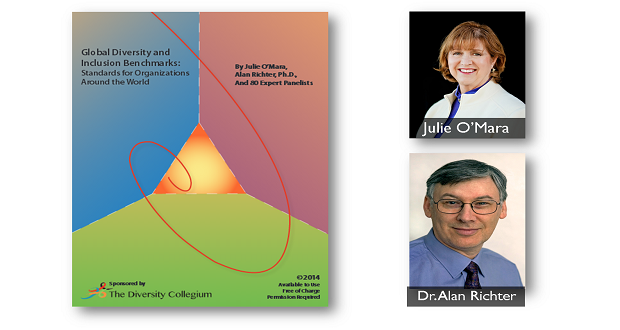
This is part 4 of a series on the Global Diversity and Inclusion Benchmarks (GDIB). Last week we outlined the internal benchmarks. This week our focus is the external benchmarks.
There has been a growing trend of placing diversity and inclusion (D&I) work under talent management within HR. One of my clients has actually moved D&I to talent acquisition. The GDIB help us to understand the need for a more comprehensive approach to D&I. It has many more intersections that are outside the HR space. The external benchmarks outline these important aspects of D&I. The external categories include:
- Community, Government Relations, and Social Responsibility. Covers the organization’s efforts to engage and invest in its communities. This category also covers government relations and social responsibility.
- Products and Services Development. Gauges the organization’s recognition of the diversity of its customer base and its effectiveness in designing and delivering products and services to current and future customers.
- Marketing, Sales, Distribution, and Customer Service. Surveys the organization’s recognition of the diversity of its customer base and its sensitivity to the nuances of language, symbols, and images used in its distribution, sales, and marketing strategies, thereby attracting and satisfying prospective and current customers.
- Supplier Diversity. This includes the processes of selecting, contracting, and interacting with the organization’s suppliers and vendors in a manner that supports and grows D&I values and goals along the supply chain.
[dropshadowbox align=”none” effect=”lifted-both” width=”600px” height=”” background_color=”#c0f0f3″ border_width=”1″ border_color=”#dddddd” ]
Category 10: COMMUNITY, GOVERNMENT RELATIONS, AND CORPORATE RESPONSIBILITY
0%
___There is limited or no involvement or support provided to communities in which the organization works.
___The organization feels threatened by any government intervention to engage in D&I.
25%
___There is some involvement in societal issues generally considered non-controversial. The organization is motivated primarily by public relations objectives and/or tax reduction.
___There is some involvement with the community, schools, and/or local government projects.
50%
___An effort is made to involve the organization with a variety of groups that support the community.
___The organization addresses social issues related to its mission and publicizes its social responsibility policy.
___Long-range community development plans are formulated with various groups, including local governments and community leaders.
___Local, community heroes are celebrated by the organization.
75%
___The organization thinks systemically, analyzing its social responsibility and investment policies (if for-profit) to consolidate initiatives.
___Community involvement reflects long-range planning and supports all segments of the population. It solicits input and involvement from diversity networks and from a wide range of its own diverse employees.
___The organization supports scholarship and internship programs that have a positive impact on both the community and the organization’s future labor force.
___The organization encourages the contribution of volunteered employee time and ideas to the community, may provide funds to organizations where employees are involved, and benefits from the D&I learning employees gain.
___The organization connects D&I with ethics and integrity initiatives, supports social justice and strives for inclusive growth, social cohesion, environmental sustainability, and economic development.
100%
___Financial resources as well as employee time and labor are provided for a variety of community projects; employees may be compensated for the time they volunteer for community involvement.
___Facilities are located to serve and promote economic growth of the whole community, particularly communities that have been historically ignored, or are presently in the greatest need.
___The organization leads in supporting and advocating for diversity-related interests in government and societal affairs.
___The organization is generous in supporting and assisting other organizations in their diversity initiatives and in promoting the advancement of D&I in the community.
___Corporate social responsibility is treated as more than philanthropy. It is perceived as a core function and is mainstreamed into organizational strategy.
___The organization provides thought-leadership on D&I and shares its success in publications and presentations.
___In connecting diversity with human rights, the organization speaks out on the issue and ensures that all its stakeholders support human rights.
___The organization supports conventions such as the Universal Declaration of Human Rights and the Global Compact, and reflects this in both heart and in action.
[/dropshadowbox]
[dropshadowbox align=”none” effect=”lifted-both” width=”600px” height=”” background_color=”#fee3e6″ border_width=”1″ border_color=”#dddddd” ]
Category 11: PRODUCTS AND SERVICES DEVELOPMENT
0%
___No effort is made to assess if differences should be designed into products and services for current and potential customers.
___Focus groups do not include a diverse population of employees or potential customers.
25%
___Research and product testing help analyze how different customer groups and cultures may use the organization’s products and services.
___There is some conversation about altering products and services based on customer demographics.
___There is some involvement in societal issues generally considered non-controversial. The organization is motivated primarily by public relations objectives and/or tax reduction.
___There is some involvement with the community, schools, and/or local government projects.
50%
___Products and services are analyzed for their value to all current and potential customers and tailored appropriately.
___Staff and/or consultants with expertise in diverse market segments are involved in product development and the revision of services or the creation of new ones.
___Diverse product-development and service analysis teams are recognized as having innovative ideas that enhance products and services.
75%
___Changes in demographics, values, and consumer behaviors are anticipated and served.
___Product adaptations for people from various groups are made (e.g., shariah-compliant financial products, products for left-handed users, adaptations for people with disabilities, and so forth).
___The organization is sensitive to the religious views, values, and cultural norms of various countries and communities and develops products and services considered appropriate for those customers.
___The organization leverages diverse teams knowing that it will greatly improve the quality and innovation of products and services.
___Employee networks are involved in product and services development.
100%
___The product-development cycle recognizes diversity from the outset. It doesn’t merely “translate” or “adapt” products and services first developed for the dominant culture. In addition, the organization does not develop products that are based on stereotypes.
___Almost all teams involved in the ongoing development of products and services are diverse and include customers, non-customers, and community representatives.
___The organization shows the link between diversity and innovation, consistently leveraging D&I to increase product and service innovation.
___Culturally-sensitive services, such as engaging a traditional healer in a hospital, are provided even though that practice may not be accepted by the dominant culture.
___Universal design is integrated throughout the product development cycle.
___The organization sees a strong connection between D&I and product sustainability, and supports bio-diversity initiatives.
[/dropshadowbox]
[dropshadowbox align=”none” effect=”lifted-both” width=”600px” height=”” background_color=”#d9f9d4″ border_width=”1″ border_color=”#dddddd” ]
Category 12: MARKETING, SALES, DISTRIBUTION, AND CUSTOMER SERVICE
0%
___The organization assumes its market is homogeneous.
___Advertising and publicity may perpetuate stereotypes and traditional roles.
___Customer service, distribution, and sales ignore differences in customer needs and country or regional infrastructure.
25%
___The organization recognizes some broad differences among its customers and attempts to understand them
___Products and services are marketed somewhat differently to different groups; advertising, however, is translated literally rather than being culturally adapted.
50%
___Some attempt is made to help different groups learn about the organization and its products.
___Some attempt is made to reach customers by using market-segment-specific media.
___Market test groups are diverse and encouraged to evaluate products and services for various groups and cultures.
___Agencies and consulting services with expertise in diversity regularly provide advice.
Marketing, advertising, and public relations reflect diversity and are positioned to reach diverse markets.
75%
___Sales and customer service training reflects D&I by providing guidelines to respectfully address specific customer needs, interests, and comfort levels.
___Diverse groups of customers and potential customers are surveyed on needs and satisfaction. The results shape marketing, sales, distribution, and customer service strategies.
___While outside D&I expertise may be sought, the organization leverages the marketing, sales, distribution, and customer service expertise of its diverse staff.
___Marketing, advertising, public relations, and all customer contact methods do not perpetuate stereotypes.
___Most marketing and customer service staff members have expertise in all dimensions and aspects of D&I, including linguistic diversity and reducing unconscious bias.
100%
___The organization uses sophisticated market analyses techniques on an ongoing basis to understand its diverse customer base.
___The organization is keenly aware of the needs, motivations, and perspectives of diverse customer groups and successfully adapts marketing, sales, and distribution strategies to meet these needs.
___It is expected that the diversity and heterogeneity of customers will likely increase over time, and the ability to successfully serve these differences is continuously reviewed and improvements made.
___To most effectively speak to target audiences, the organization uses a systemic, universal marketing and customer service approach that can be adapted within and across countries, regions, cultures, language and other diversity dimensions.
[/dropshadowbox]
[dropshadowbox align=”none” effect=”lifted-both” width=”600px” height=”” background_color=”#d3d3d3″ border_width=”1″ border_color=”#dddddd” ]
Category 13: SUPPLIER DIVERSITY
0%
___No consideration is given to diversity when determining suppliers.
___There is no awareness of the value that diverse suppliers bring to the organization.
25%
___There is some attempt to include a few suppliers outside of traditional sources, but it is done without an underlying strategy to support organizational goals.
___The organization is beginning to use underrepresented vendors for small or low-fee contracts.
___There is little collaboration between the procurement function, where relationships with suppliers are usually managed, and the D&I function.
50%
___A supplier database includes information about the ownership of organizations that supply goods or services and how diverse its employees are.
___Supplier diversity has become important to the organization and the organization has dedicated resources (staffing and funding) to implement the supplier diversity strategy.
___Input from underrepresented suppliers is included in the organization’s supplier diversity program.
___D&I education specific to supplier relations is provided to all staff who interact with suppliers.
___The organization regularly participates in trade fairs, special advertising and seeks other opportunities to inform underrepresented suppliers that the organization welcomes their business.
___Policies and practices promote the use of suppliers who previously may have been excluded.
75%
___The organization is proactive in attracting underrepresented suppliers and in informing new and established suppliers of additional opportunities with the organization.
___Underrepresented suppliers are sometimes given additional points in the bidding process.
___The organization treats its suppliers with respect and dignity including simplifying the process of doing business and paying supplier invoices as soon as possible.
___Persons involved in the supplier selection process are knowledgeable about D&I and aware of the potential impact of hidden bias as they select and work with suppliers.
___Educational assistance and coaching is provided to underrepresented suppliers and potential suppliers to help them be more competitive.
___The organization participates in supplier diversity councils and/or organizations.
100%
___The organization’s suppliers are required to have a significant percentage of their business with diverse suppliers and to provide evidence that they are committed to achieving their own D&I goals.
___Suppliers reflect the community’s composition along a broad range of diversity dimensions.
___The organization collaborates with its underrepresented suppliers to improve the supply chain and all aspects of supply management.
___The organization acknowledges and promotes the benefits of excellent supplier relations in meeting both its business and community/social goals.
___The Supplier Diversity function is fully aligned with the D&I function, marketing, and all other related functions.
___The organization procures both small and non-critical supplies as well as goods and services that are core to the business from underrepresented suppliers.
[/dropshadowbox]
Where does your organization stand? How would you rate it on the external benchmarks? Can you say you are mostly at best practice or mostly at 0%?


















